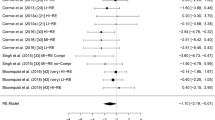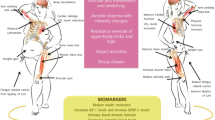Abstract
Background
Breast lymphoedema can occur following surgical treatment for breast cancer. We investigated whether an exercise program reduced breast lymphoedema symptoms compared to a non-exercise control group.
Methods
A single-blinded randomised controlled trial was conducted in which women with stable breast lymphoedema (n = 89) were randomised into an exercise (n = 41) or control (n = 47) group. The intervention comprised a 12-week combined aerobic and resistance training program, supervised weekly by an accredited exercise physiologist. All participants completed a weekly symptoms diary and were assessed monthly to ensure that there was no exacerbation of their lymphoedema. Changes in the breast were captured physically with ultrasound and bioimpedance spectroscopy and changes in symptoms were captured using European Organization for Research and Treatment of Cancer (EORTC) Breast Cancer (BR23) and Lymphoedema Symptom Intensity and Distress questionnaires.
Results
The exercise group reported a greater reduction in breast-related symptoms than the control group, assessed by the EORTC BR23 breast symptom questions. Measures of extracellular fluid, assessed with bioimpedance spectroscopy ratio, decreased in the exercise group compared to the control group. No significant difference was detected in dermal thickness in the breast, assessed by ultrasound. Session attendance in the exercise sessions was high, with two musculoskeletal adverse events reported, but no exacerbations of lymphoedema observed.
Conclusion
Combined resistance and aerobic exercise training is safe for women living with breast lymphoedema. Preliminary data suggest exercise training can reduce breast lymphoedema symptoms to a greater extent than usual care.



Similar content being viewed by others
Data availability
The datasets from the current study are available from the corresponding author on reasonable request.
References
Verbelen H, Gebruers N, Beyers T, De Monie AC, Tjalma W (2014) Breast edema in breast cancer patients following breast-conserving surgery and radiotherapy: a systematic review. Breast Cancer Res Treat 147:463–471
Young-Afat DA, Gregorowitsch ML, van den Bongard DH, Burgmans I, van der Pol CC, Witkamp AJ et al (2019) Breast edema following breast-conserving surgery and radiotherapy: patient-reported prevalence, determinants, and effect on health-related quality of life. JNCI Cancer Spectr 3(2):pkz011
Sierla R, Lee TS, Black D, Kilbreath SL (2013) Lymphedema following breast cancer: regions affected, severity of symptoms, and benefits of treatment from the patients’ perspective. Clin J Oncol Nurs 17:325–331
Turner J, Hayes S, Reul-Hirche H (2004) Improving the physical status and quality of life of women treated for breast cancer: a pilot study of a structured exercise intervention. J Surg Oncol 86:141–146
Schmitz KH, Ahmed RL, Troxel A, Cheville A, Smith R, Lewis-Grant L et al (2009) Weight lifting in women with breast-cancer-related lymphedema. N Engl J Med 361:664–673
Singh B, Disipio T, Peake J, Hayes SC (2016) Systematic review and meta-analysis of the effects of exercise for those with cancer-related lymphedema. Arch Phys Med Rehabil 97(2):302–315
Baumann FT, Reike A, Reimer V, Schumann M, Hallek M, Taaffe DR et al (2018) Effects of physical exercise on breast cancer-related secondary lymphedema: a systematic review. Breast Cancer Res Treat 170:1–13
Hasenoehrl T, Keilani M, Palma S, Crevenna R (2020) Resistance exercise and breast cancer related lymphedema—a systematic review update. Disabil Rehabil 42:26–35
Thomas S, Reading J, Shephard RJ (1992) Revision of the Physical Activity Readiness Questionnaire (PAR-Q). Can J Sport Sci 17:338–345
Ward LC, Degnim AC, Dylke ES, Kilbreath SL (2020) Bioimpedance spectroscopy of the breast. Lymphat Res Biol. https://doi.org/10.1089/lrb.2019.0087
Ward LC, Kilbreath S, Cornish BH (2008) Bioimpedance analysis for early detection of lymphedema. In: Weissieder H, Schuchhardt C (eds) Lymphedema: diagnosis and therapy, 4th edn. Viavital Verlag Gmbh Publ, Essen, pp 502–517
Gearhart RE, Goss FL, Lagally KM, Jakicic JM, Gallagher J, Robertson RJ (2001) Standardized scaling procedures for rating perceived exertion during resistance exercise. J Strength Cond Res 15:320–325
Aaronson NK, Ahmedzai S, Bergman B, Bullinger M, Cull A, Duez NJ et al (1993) The European Organization for Research and Treatment of Cancer QLQ-C30: a quality-of-life instrument for use in international clinical trials in oncology. J Natl Cancer Inst 85:365–376
Hjermstad MJ, Fossa SD, Bjordal K, Kaasa S (1995) Test/retest study of the European Organization for Research and Treatment of Cancer Core Quality-of-Life Questionnaire. J Clin Oncol 13:1249–1254
Ridner SH, Dietrich MS (2015) Development and validation of the lymphedema symptom and intensity survey-arm. Support Care Cancer 23:3103–3112
Czerniec SA, Ward LC, Refshauge KM, Beith J, Lee MJ, York S et al (2010) Assessment of breast cancer-related arm lymphedema—comparison of physical measurement methods and self-report. Cancer Investig 28:54–62
Ward LC, Dylke E, Czerniec S, Isenring E, Kilbreath SL (2011) Confirmation of the reference impedance ratios used for assessment of breast cancer-related lymphedema by bioelectrical impedance spectroscopy. Lymphat Res Biol 9:47–51
Dylke ES, Benincasa Nakagawa H, Lin L, Clarke JL, Kilbreath SL (2018) Reliability and diagnostic thresholds for ultrasound measurements of dermal thickness in breast lymphedema. Lymphat Res Biol 16:258–262
Wratten CR, O’Brien PC, Hamilton CS, Bill D, Kilmurray J, Denham JW (2007) Breast edema in patients undergoing breast-conserving treatment for breast cancer: assessment via high frequency ultrasound. Breast J 13:266–273
Institute of Medical Illustrators (2007) IMI National Guidelines for clinical photography in wound management. https://imi.org.uk/guidelines/IMINatGuidelinesWoundManagement.pdf
Brzycki M (1993) Strength testing—predicting a one-rep max from reps-to-fatigue. J Phys Educ Recreat Dance 64:88–90
American College of Sports Medicine (2014) ACSM’s guidelines for exercise testing and prescription, 9th edn. Lippincott Williams & Wilkins, Philadelphia
Lombard JM, Zdenkowski N, Wells K, Beckmore C, Reaby L, Forbes JF et al (2016) Aromatase inhibitor induced musculoskeletal syndrome: a significant problem with limited treatment options. Support Care Cancer 24:2139–2146
Nelson NL (2016) Breast cancer-related lymphedema and resistance exercise: a systematic review. J Strength Cond Res 30:2656–2665
Zawieja D (2005) Lymphatic biology and the microcirculation: past, present and future. Microcirculation 12:141–150
Scallan JP, Zawieja SD, Castorena-Gonzalez JA, Davis MJ (2016) Lymphatic pumping: mechanics, mechanisms and malfunction. J Physiol (Lond) 594:5749–5768
Ji R-C (2018) Recent advances and new insights into muscular lymphangiogenesis in health and disease. Life Sci 211:261–269
Engeset A, Olszewski W, Jaeger PM, Sokolowski J, Theodorsen L (1977) Twenty-four hour variation in flow and composition of leg lymph in normal men. Acta Physiol Scand 99:140–148
McGeown JG, McHale NG, Thornbury KD (1987) The role of external compression and movement in lymph propulsion in the sheep hind limb. J Physiol 387:83–93
Coates G, O’Brodovich H, Goeree G (1993) Hindlimb and lung lymph flows during prolonged exercise. J Appl Physiol 75:633–638
Suami H, Pan W-R, Mann GB, Taylor GI (2008) The lymphatic anatomy of the breast and its implications for sentinel lymph node biopsy: a human cadaver study. Ann Surg Oncol 15:863–871
Hacard F, Machet L, Caille A, Tauveron V, Georgescou G, Rapeneau I et al (2014) Measurement of skin thickness and skin elasticity to evaluate the effectiveness of intensive decongestive treatment in patients with lymphoedema: a prospective study. Skin Res Technol 20:274–281
Verbelen H, De Vrieze T, Van Soom T, Meirte J, Van Goethem M, Hufkens G et al (2020) Development and clinimetric properties of the Dutch Breast Edema Questionnaire (BrEQ-Dutch version) to diagnose the presence of breast edema in breast cancer patients. Qual Life Res 29:569–578
Funding
This research is supported by a National Health and Medical Research Grant (APP1021608).
Author information
Authors and Affiliations
Corresponding author
Ethics declarations
Conflict of interest
Author B consults to ImpediMed Ltd., a manufacturer of impedance devices. ImpediMed Ltd. was not involved in the conceptualisation, design or execution of this study, nor in any preparation of the manuscript. Authors A, C, D, E, F and G have no conflicts of interest to report.
Ethical approval
All procedures performed in this study involving human participants were conducted in accordance with the 1964 Helsinki declaration and its later amendments or comparable ethical standards and approved by Royal Prince Alfred Hospital Human Ethics Review Committee (Reference Number X12-0144 & HREC/12/RPAH/239).
Informed consent
Informed consent was obtained from all individual participants included in this study.
Additional information
Publisher's Note
Springer Nature remains neutral with regard to jurisdictional claims in published maps and institutional affiliations.
Rights and permissions
About this article
Cite this article
Kilbreath, S.L., Ward, L.C., Davis, G.M. et al. Reduction of breast lymphoedema secondary to breast cancer: a randomised controlled exercise trial. Breast Cancer Res Treat 184, 459–467 (2020). https://doi.org/10.1007/s10549-020-05863-4
Received:
Accepted:
Published:
Issue Date:
DOI: https://doi.org/10.1007/s10549-020-05863-4




